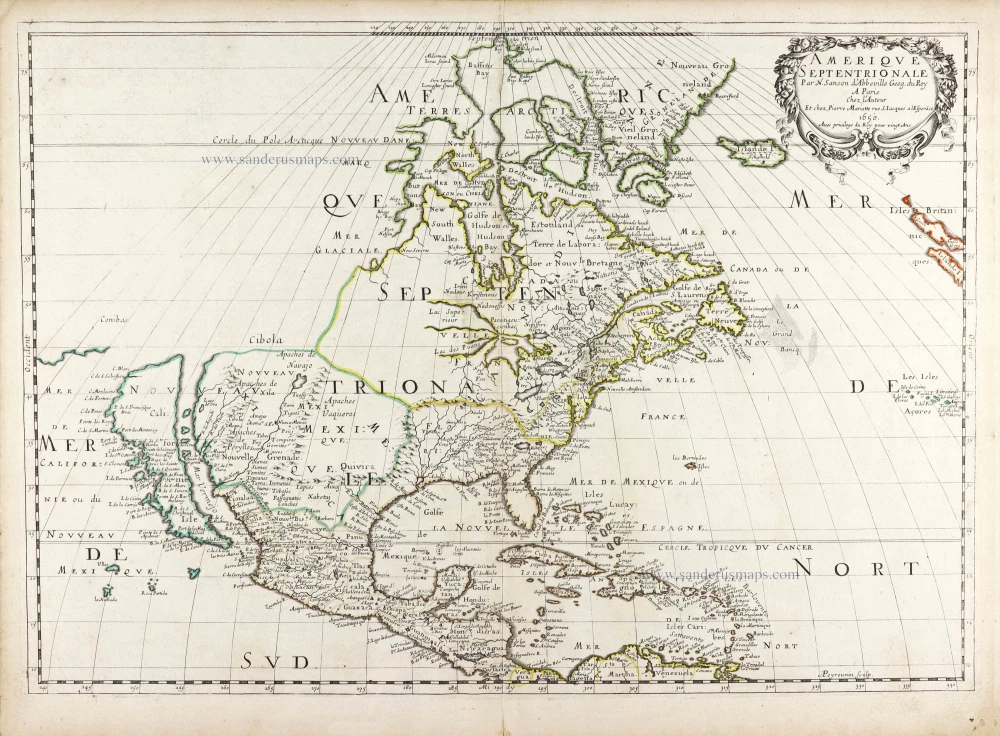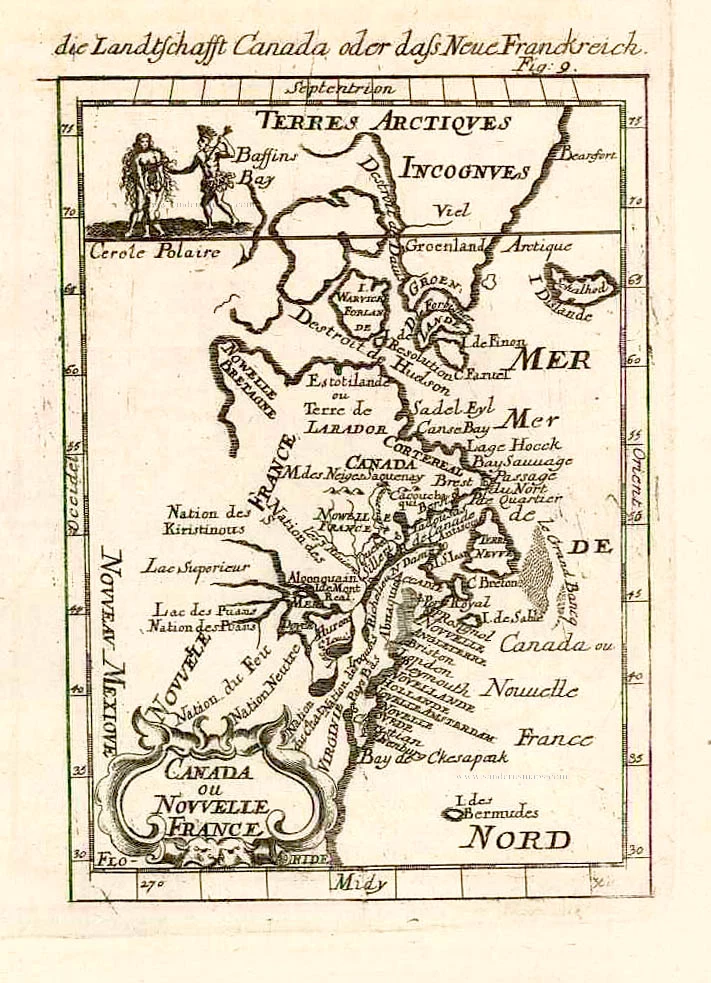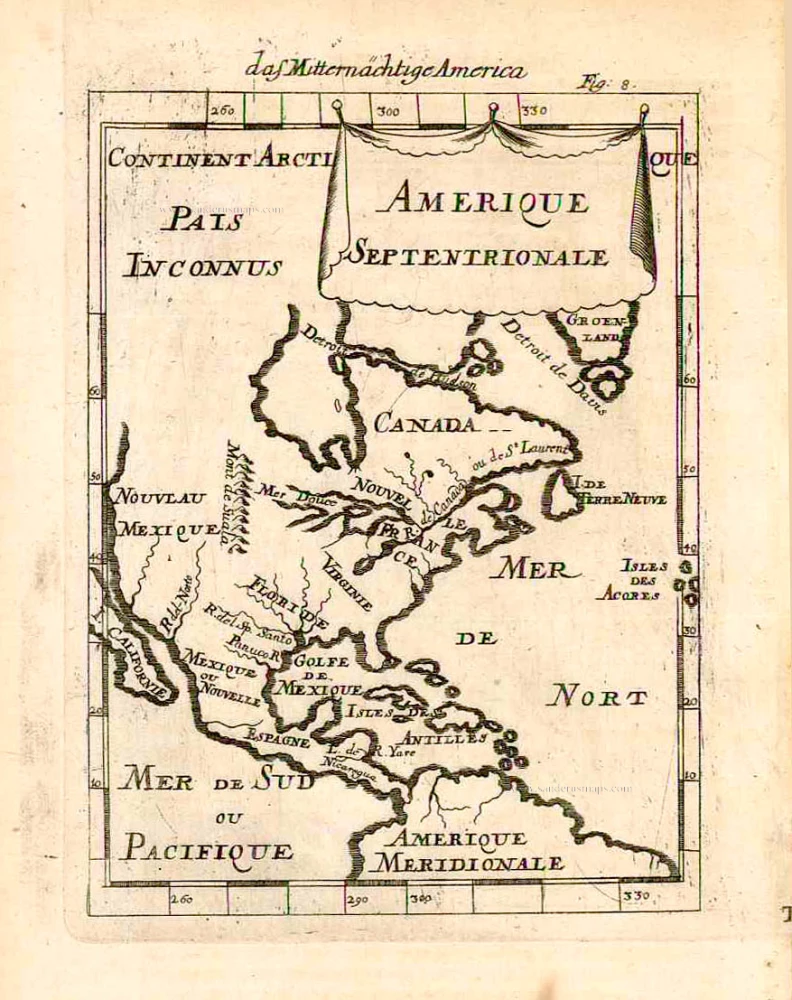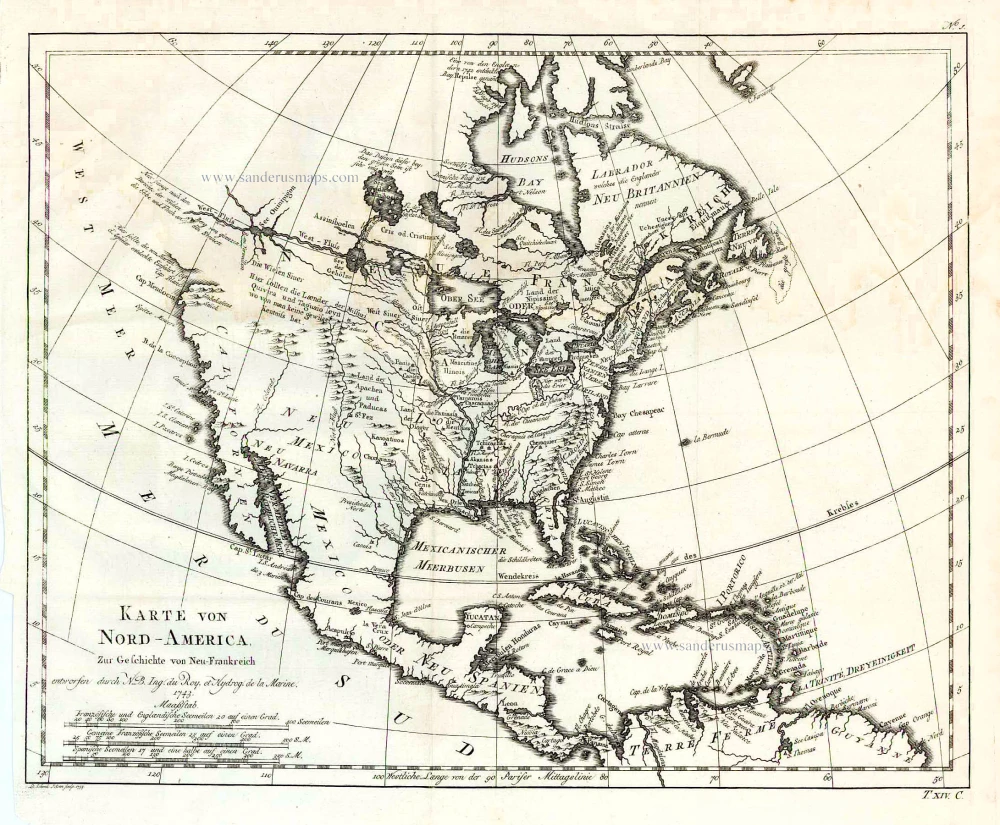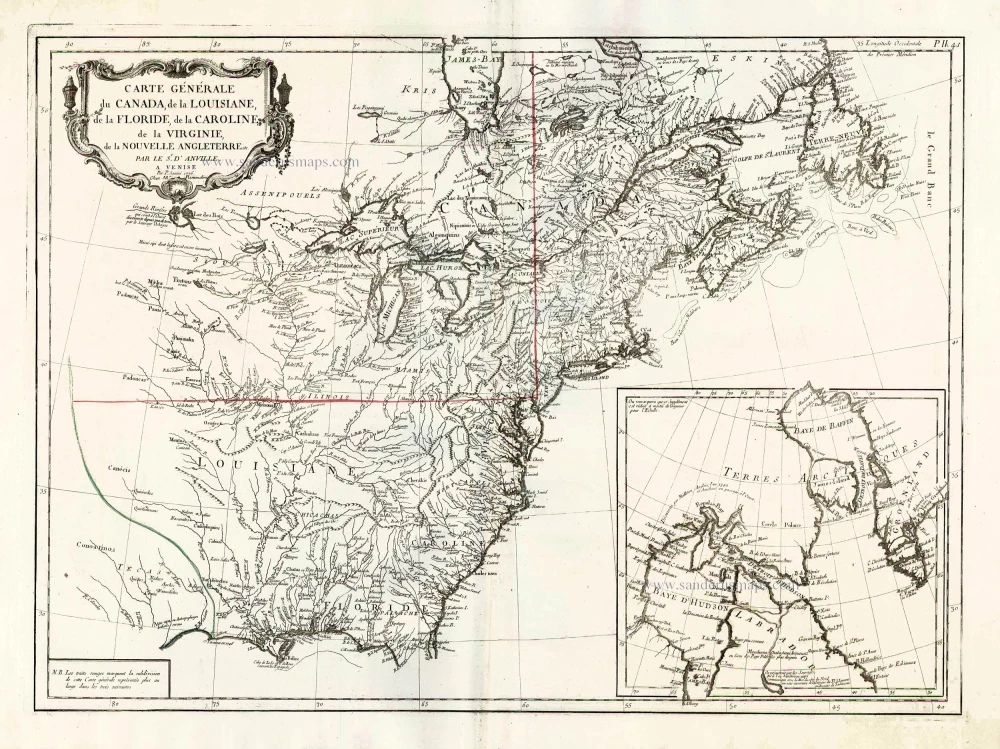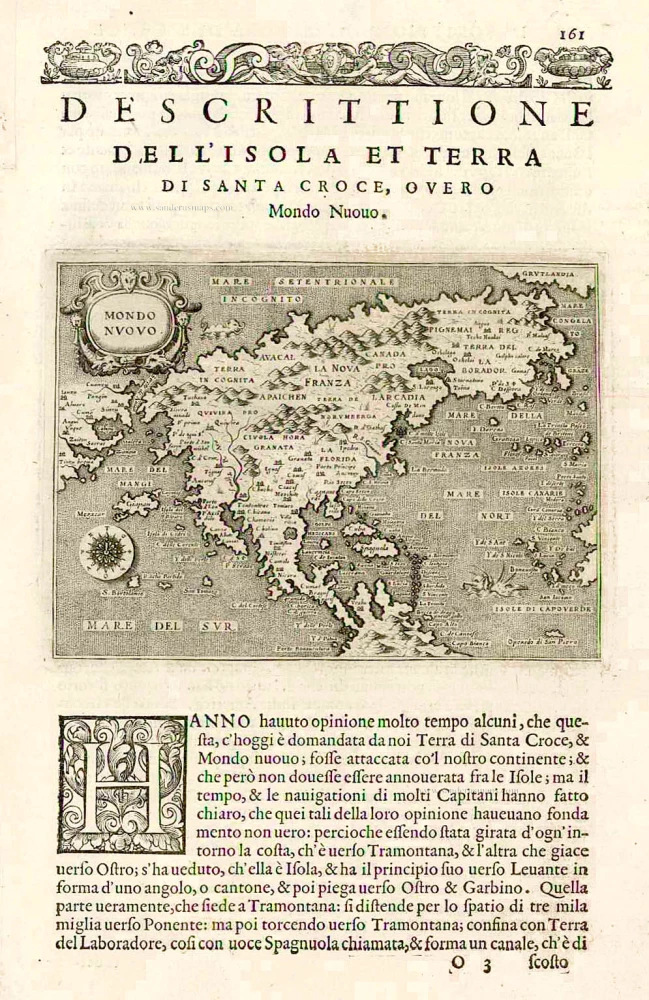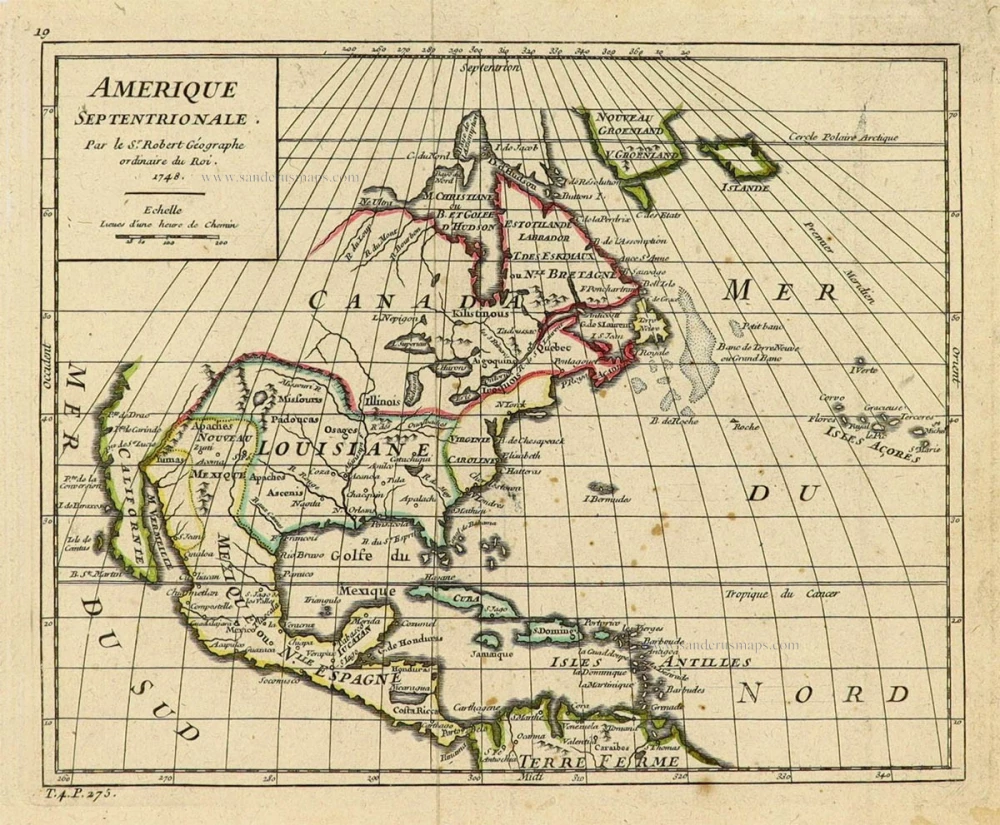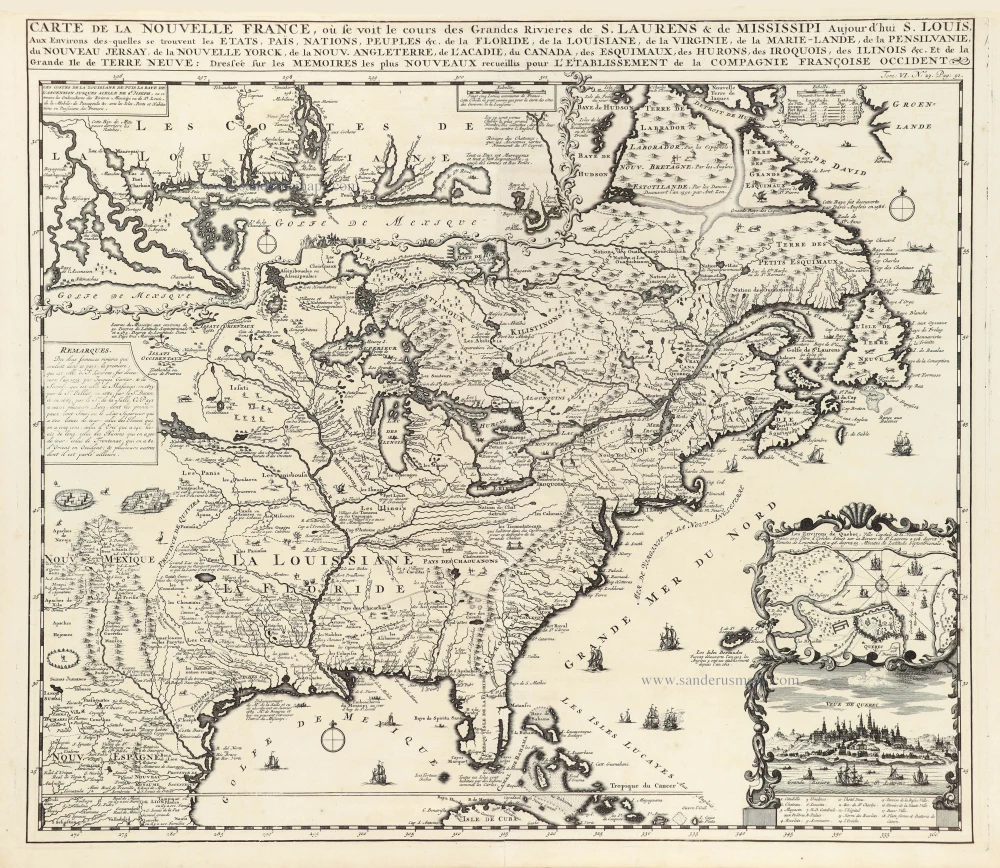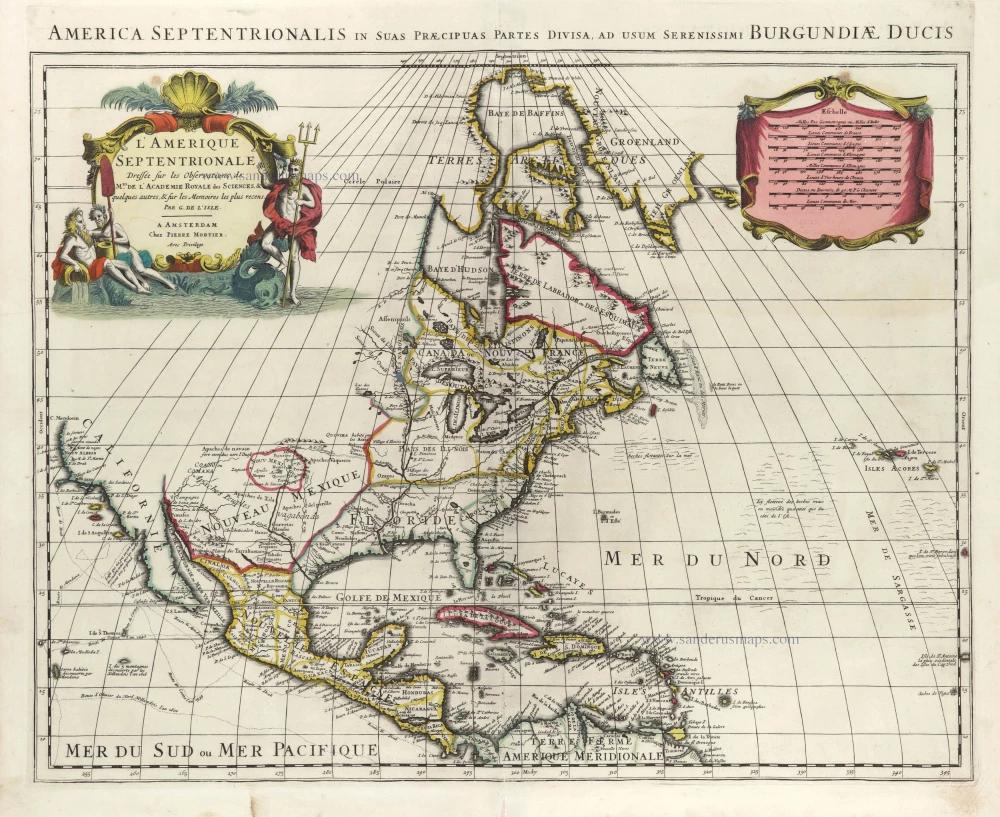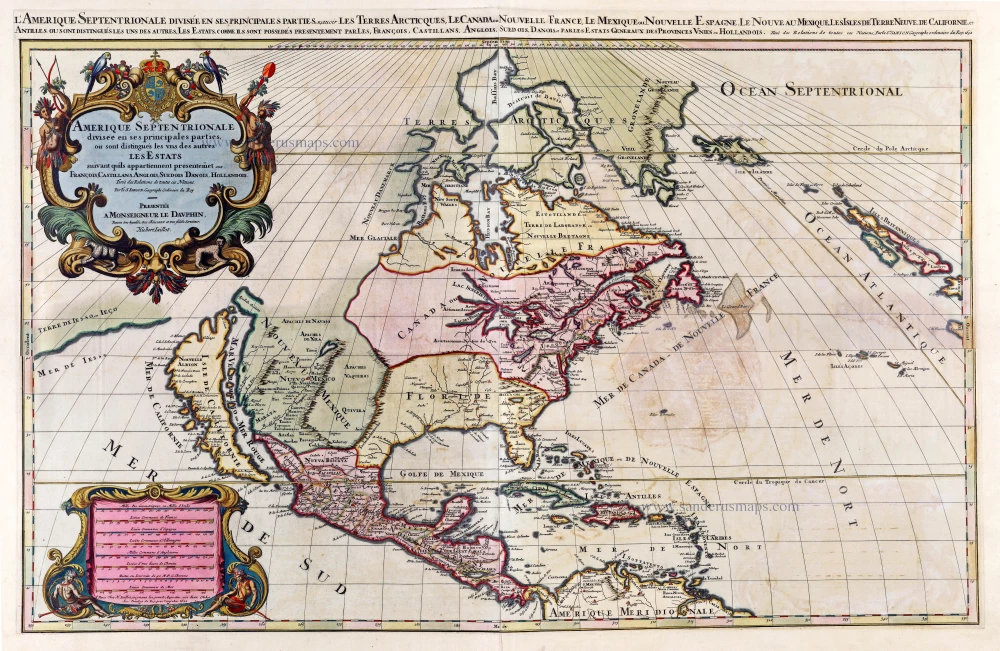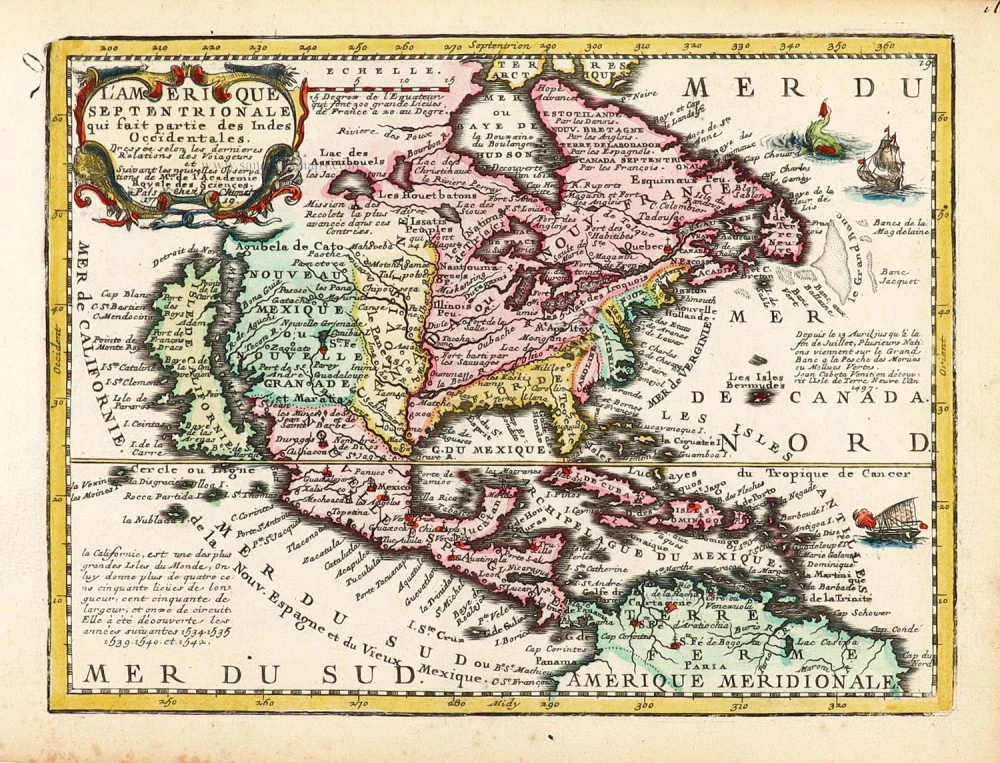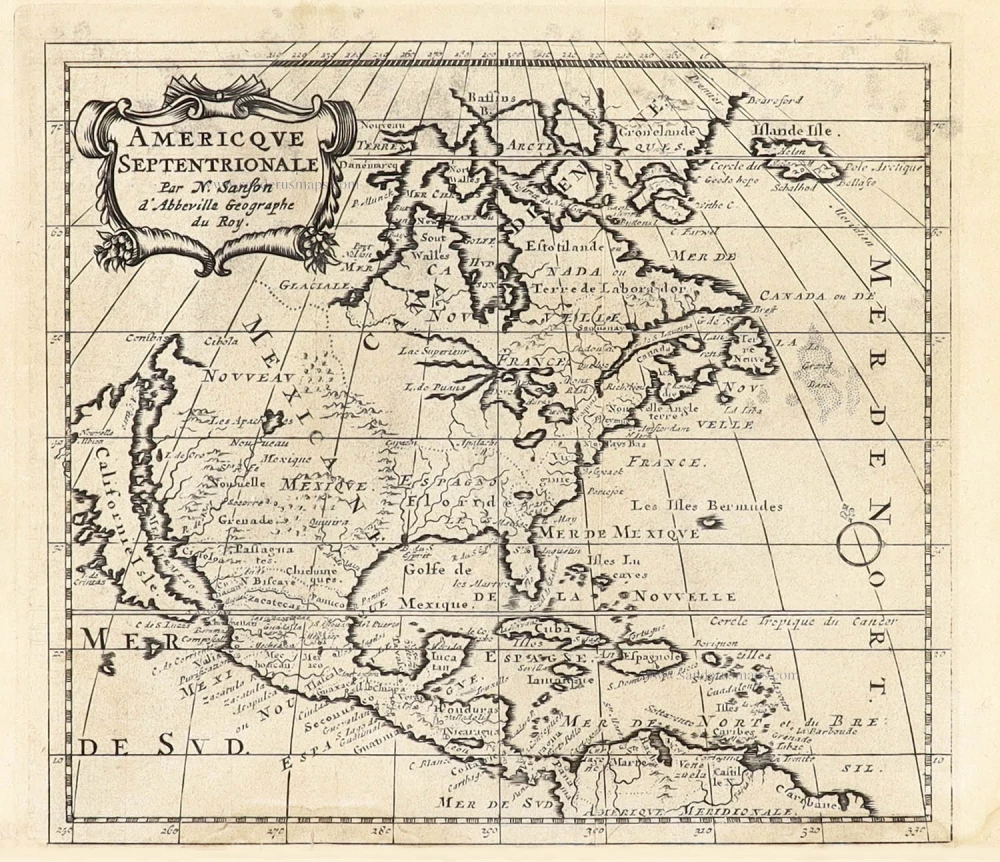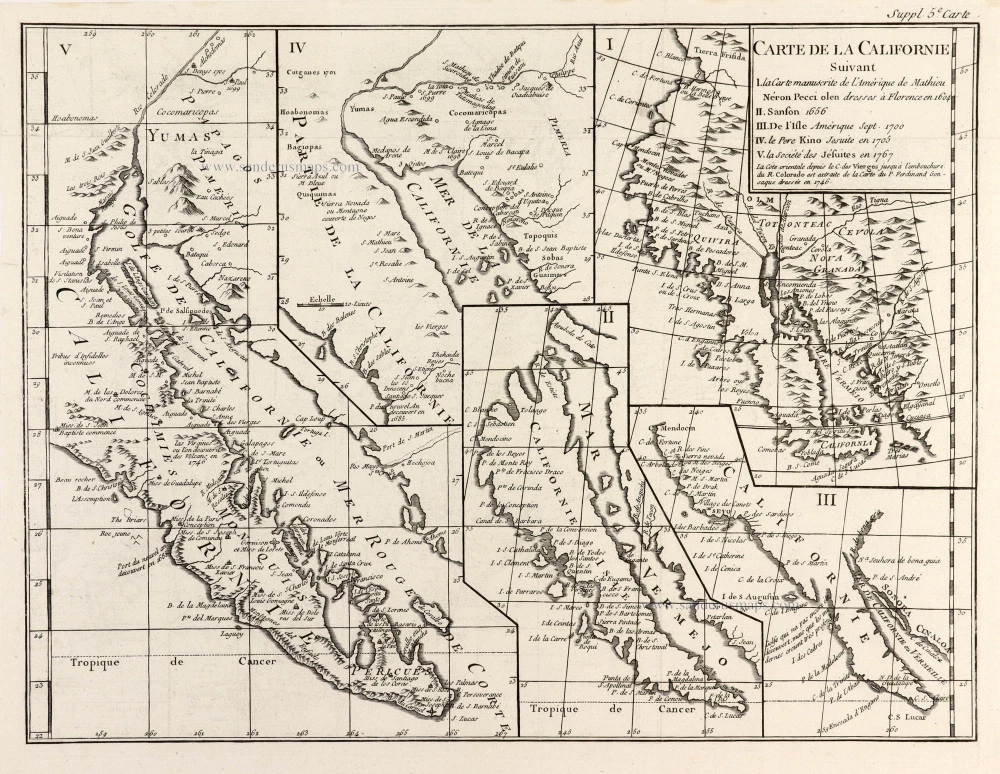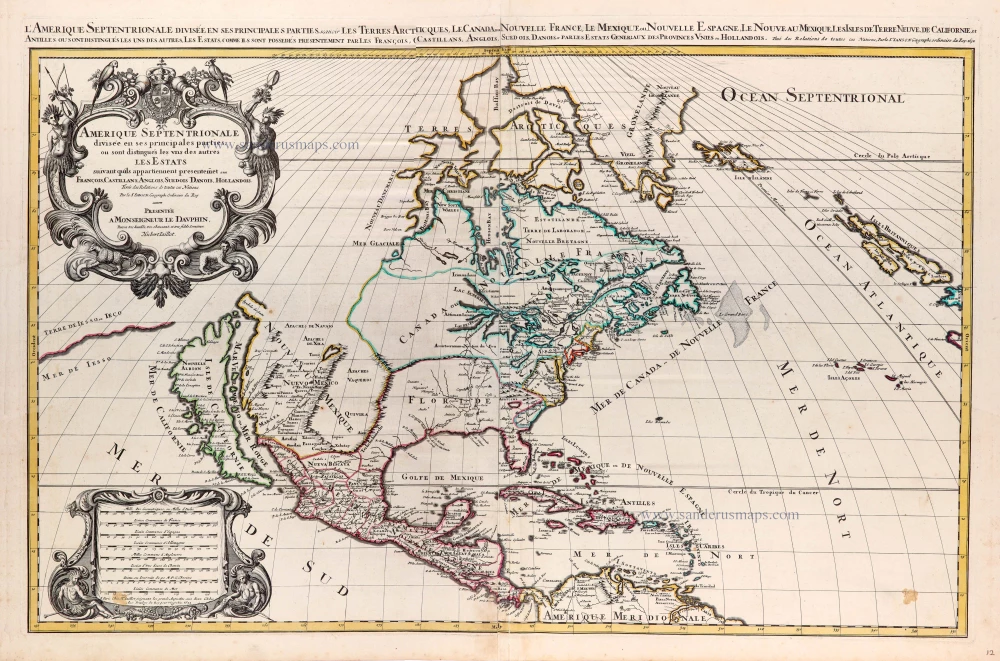Landmark map of North Amerika
Nicolas Sanson's landmark map of North America, scarce second state. 1652
In 1650 Sanson published this landmark map of North America. It was drawn, with his usual care, using the sinusoidal projection, sometimes known as Sanson-Flamstead. It is, perhaps, most important for being the first printed map to delineate the five Great Lakes in a recognisable form.
Sanson's map was the first to name lakes Superior and Ontario, and Lakes Erie and Huron, unnamed, appear in a more familiar form. His sources were largely the so-called Jesuit Relations, the extremely detailed annual reports on the progress of their missions in New France. Most of the information was from firsthand accounts.
Montreal, recorded here at the important junction of the R des Prairies, Ottawa River, and the St. Lawrence River, was chosen by Champlain in 1611 as the site for a trading post. Still, it was not until 1643 that it became occupied year-round. The waters of the north illustrate the continued hope of a North-West Passage. The majority of the cartography of New France was new and would remain the most accurate until superseded by Coronelli in 1688. The east coast of North America does not bear much detail, but one interesting feature is the location of Nouvelle Amsterdam on an island some distance offshore. The reference to N. Suede is the first on a printed map of the Swedish colony founded in 1638. The south and southeast are largely similar to those of the Hondius, America Septentionalis, 1636.
To the west S Fe, Navajo, Apache, Taosij, and others all appear for the first time. The first is incorrectly placed on the west bank of the Rio Grande, here again flowing to the southwest. These were the first advances in the geography of this region for some time. The information was derived from the travels of Father Alonso de Benavides in the late 1620s, as published in his Memorial, Madrid, 1630. California, as an island, is of the Briggs type with some alterations.
There are three known states of the map. The first is extremely rare, known by only two examples. The second is also uncommon, seemingly appearing in only the first edition of the atlas. (Burden)
Nicolas Sanson (1600-1667) - Guillaume Sanson (1633-1703)
Originally from Abbeville, Nicolas I Sanson showed a keen interest in historical geography. Still very young, he published a map of ancient Gaul and two treatises, Britannia and Portus Itius on Abbeville and Boulogne's origins. His meeting with Melchior Tavernier was decisive: it prompted him to give up his duties as a military engineer in Picardy and devote himself to engraved cartography.
At the same time, Sanson had drawn up the outline of modern France. He got the help of Tavernier who encouraged him to compete with the Dutch map publishers. Tavernier contacted other French cartographers whose works he published.
From 1643, N. Sanson obtained a privilege to publish a work personally, the Princes souverains de l'Italie. Then, in 1644 and 1645, he had his famous geographical tables printed, which significantly contributed to his fame. He also published a series of atlases in quarto of the four continents.
In 1648, N. Sanson associated himself with Mariette for the publishing of atlases. From then on, certain maps bore his name, and others Mariette's. N. Sanson and Mariette worked together for more than 20 years. After the death of N. Sanson, Mariette acquired the entire fund. Since Mariette only wanted to publish complete atlases, individual maps were no longer sold, and some army generals complained to the king.
The disagreement between the Sanson family and Pierre II Mariette culminated in 1671 when Guillaume Sanson took the case to court. From then on, there was no longer any question of collaboration: Guillaume Sanson started working for another publisher, Alexis-Hubert Jaillot.
The Sanson family faced financial difficulties, and in 1692, their cousin, Pierre Moullart-Sanson, bought the entire geographic fund from his uncles and aunt. Moullart-Sanson restarted the publishing of Sanson's world atlas, and in 1704 he acquired a privilege for publishing all the works of Nicolas and Guillaume Sanson, which continued to be published until 1730.
Pierre Mariette (1602-1658)
Bookseller, printseller, printer, and publisher, located in the Rue Saint-Jacques in Paris. On February 12, 1644, Pierre Mariette acquired most of Melchior Tavernier's fund. In 1646, he had a series of maps by Blaeu copied and asked Abraham Peyrounin to engrave them. In the meantime, he published the works of Nicolas Sanson. In 1650, he published the atlas Théâtre Géographique de France. A second edition followed in 1653. He later contributed to Sanson's atlas, the Cartes générales de toutes les parties du monde. Many maps of Mariette's Théatre appeared in later editions of Sanson's Cartes générales.
Amerique Septentrionale.
Item Number: 29597 Authenticity Guarantee
Category: Antique maps > America > North America
Scarce second state of Nicolas Sanson's landmark map of North America.
Title: Amerique Septentrionale.
Par N. Sanson d'Abbeville Geog. du Roy
A Paris chez Pierre Mariette rue s. Iacques a l'€sperace
1650.
Avec privilege du Roy pour vingt Ans.
APeyrounin sculp.
Engraver: Abraham Peyrounin.
Date of the first edition: 1650.
Date of this map: 1652.
Date on map: 1650.
Copper engraving, printed on paper.
Map size: 390 x 550mm (15.35 x 21.65 inches).
Sheet size: 430 x 580mm (16.93 x 22.83 inches).
Verso: Blank
Condition: Original coloured in outline, excellent.
Condition Rating: A+.
From: Atlas with Sanson maps, without a title page, published by Pierre Mariette. 1652.
Pastoureau, p. 401: "En 1652, on les voit [les cartes de Sanson] pour la première fois réunies en un recueil sans titre, mais dont la structure est celle d'un atlas du monde. Ce recueil, daté par son ex-libris, contient 70 cartes dont 14 de géographie ancienne." (In 1652, we see them [Sanson's maps] for the first time brought together in an untitled collection, but whose structure is that of an atlas of the world. This collection, dated by its ex-libris, contains 70 maps including 14 of ancient geography.)
In 1650 Sanson published this landmark map of North America. It was drawn, with his usual care, using the sinusoidal projection, sometimes known as Sanson-Flamstead. It is, perhaps, most important for being the first printed map to delineate the five Great Lakes in a recognisable form.
Sanson's map was the first to name lakes Superior and Ontario, and Lakes Erie and Huron, unnamed, appear in a more familiar form. His sources were largely the so-called Jesuit Relations, the extremely detailed annual reports on the progress of their missions in New France. Most of the information was from firsthand accounts.
Montreal, recorded here at the important junction of the R des Prairies, Ottawa River, and the St. Lawrence River, was chosen by Champlain in 1611 as the site for a trading post. Still, it was not until 1643 that it became occupied year-round. The waters of the north illustrate the continued hope of a North-West Passage. The majority of the cartography of New France was new and would remain the most accurate until superseded by Coronelli in 1688. The east coast of North America does not bear much detail, but one interesting feature is the location of Nouvelle Amsterdam on an island some distance offshore. The reference to N. Suede is the first on a printed map of the Swedish colony founded in 1638. The south and southeast are largely similar to those of the Hondius, America Septentionalis, 1636.
To the west S Fe, Navajo, Apache, Taosij, and others all appear for the first time. The first is incorrectly placed on the west bank of the Rio Grande, here again flowing to the southwest. These were the first advances in the geography of this region for some time. The information was derived from the travels of Father Alonso de Benavides in the late 1620s, as published in his Memorial, Madrid, 1630. California, as an island, is of the Briggs type with some alterations.
There are three known states of the map. The first is extremely rare, known by only two examples. The second is also uncommon, seemingly appearing in only the first edition of the atlas. (Burden)
Nicolas Sanson (1600-1667) - Guillaume Sanson (1633-1703)
Originally from Abbeville, Nicolas I Sanson showed a keen interest in historical geography. Still very young, he published a map of ancient Gaul and two treatises, Britannia and Portus Itius on Abbeville and Boulogne's origins. His meeting with Melchior Tavernier was decisive: it prompted him to give up his duties as a military engineer in Picardy and devote himself to engraved cartography.
At the same time, Sanson had drawn up the outline of modern France. He got the help of Tavernier who encouraged him to compete with the Dutch map publishers. Tavernier contacted other French cartographers whose works he published.
From 1643, N. Sanson obtained a privilege to publish a work personally, the Princes souverains de l'Italie. Then, in 1644 and 1645, he had his famous geographical tables printed, which significantly contributed to his fame. He also published a series of atlases in quarto of the four continents.
In 1648, N. Sanson associated himself with Mariette for the publishing of atlases. From then on, certain maps bore his name, and others Mariette's. N. Sanson and Mariette worked together for more than 20 years. After the death of N. Sanson, Mariette acquired the entire fund. Since Mariette only wanted to publish complete atlases, individual maps were no longer sold, and some army generals complained to the king.
The disagreement between the Sanson family and Pierre II Mariette culminated in 1671 when Guillaume Sanson took the case to court. From then on, there was no longer any question of collaboration: Guillaume Sanson started working for another publisher, Alexis-Hubert Jaillot.
The Sanson family faced financial difficulties, and in 1692, their cousin, Pierre Moullart-Sanson, bought the entire geographic fund from his uncles and aunt. Moullart-Sanson restarted the publishing of Sanson's world atlas, and in 1704 he acquired a privilege for publishing all the works of Nicolas and Guillaume Sanson, which continued to be published until 1730.
Pierre Mariette (1602-1658)
Bookseller, printseller, printer, and publisher, located in the Rue Saint-Jacques in Paris. On February 12, 1644, Pierre Mariette acquired most of Melchior Tavernier's fund. In 1646, he had a series of maps by Blaeu copied and asked Abraham Peyrounin to engrave them. In the meantime, he published the works of Nicolas Sanson. In 1650, he published the atlas Théâtre Géographique de France. A second edition followed in 1653. He later contributed to Sanson's atlas, the Cartes générales de toutes les parties du monde. Many maps of Mariette's Théatre appeared in later editions of Sanson's Cartes générales.

